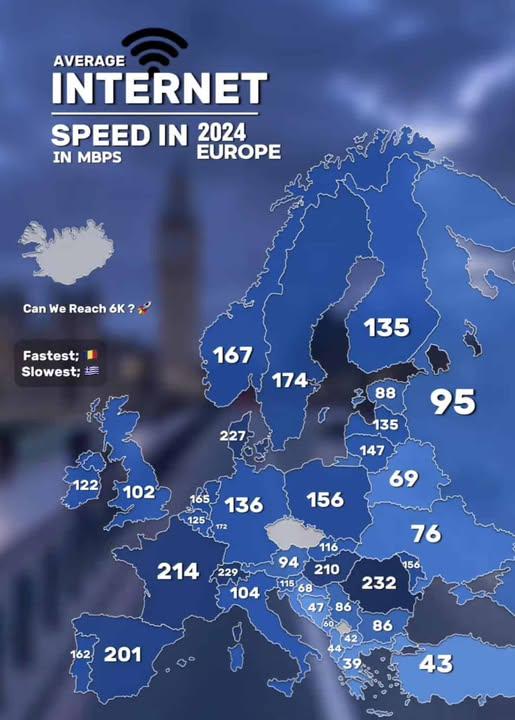Average European Internet Speed By Country Map


David Chen
Data Visualization Specialist
David Chen is an expert in transforming complex geographic datasets into compelling visual narratives. He combines his background in computer science ...
Geographic Analysis
What This Map Shows\nThis map provides a clear and concise visualization of the average internet speeds experienced across different countries in Europe for the year 2024. As our world becomes increasingly digital, understanding internet connectivity is crucial for both individuals and businesses. The map highlights the disparities in internet speed, showcasing which countries are leading in high-speed internet access and which are lagging behind. This data is not just numbers; it reflects the technological landscape and infrastructure development of each nation.
Deep Dive into Internet Speed in Europe\nThe average internet speed in a country can have profound implications for its economy, education, and overall quality of life. Internet speed is influenced by several factors, including infrastructure, investment in technology, population density, and regulatory environments. In 2024, countries like Monaco, Switzerland, and the Netherlands are at the forefront, boasting average speeds well above 100 Mbps. For instance, Monaco stands out with an impressive average speed of around 260 Mbps, which positions it as a global leader in internet connectivity.
Interestingly, these high speeds are linked to advanced telecommunications infrastructures, such as fiber-optic networks. Countries investing heavily in these technologies tend to offer better internet services. For example, Sweden has long been recognized for its commitment to providing high-speed internet to both urban and rural areas, making it accessible to a wider population.
On the other hand, countries like Albania and Moldova show average speeds below 30 Mbps, reflecting challenges in infrastructure and investment. These lower speeds can hinder economic growth, limit access to e-learning resources, and impact businesses that rely on digital connectivity. The disparity in internet speed across Europe not only highlights technological advancement but also shines a light on socio-economic inequalities that can arise from such gaps.
Moreover, the digital divide is more pronounced in Eastern European countries compared to their Western counterparts. This divide can be attributed to various factors, including historical economic conditions and varying levels of government investment in technology. For example, while Finland and Estonia have embraced digital innovation and connectivity, countries like Ukraine are still working to catch up.
Regional Analysis\nWhen we break down the map by regions, we see some intriguing patterns. Northern Europe, particularly the Nordic countries, consistently ranks high for internet speeds. Finland, Sweden, and Denmark not only prioritize technological investment but also have policies that encourage widespread internet access. In contrast, Southern and Eastern Europe tend to lag, with countries like Greece and Romania showing slower speeds on average.
Interestingly, the United Kingdom also shows a varied landscape. While cities like London boast high speeds, rural areas still struggle with connectivity, underscoring the urban-rural divide in internet access. Similarly, in countries like Italy, internet speed can vary dramatically between regions, highlighting the importance of local infrastructure and investment.
In Central Europe, Germany and Austria are doing well, but there’s still room for growth compared to their Western counterparts. The competition among countries in this region to enhance internet speed is becoming more pronounced, with Germany focusing on improving fiber-optic networks to meet future demands.
Significance and Impact\nThe implications of internet speed are far-reaching. Fast internet is not just a luxury; it is essential for modern business operations, education, and communication. Countries that provide faster internet can attract tech companies and encourage innovation, leading to economic growth. Furthermore, as remote work becomes more prevalent, the need for reliable and high-speed internet will only increase.
Interestingly, the COVID-19 pandemic has accelerated the demand for internet connectivity as more people transitioned to online work and learning. This trend is likely to continue, making it crucial for governments to invest in infrastructure. In fact, countries that prioritize internet speed see benefits in various sectors, from education to healthcare, as they become more digitally connected and resourceful.
As we look to the future, the need for speed will only grow. Projections suggest that internet speeds will continue to rise, driven by advancements in technology such as 5G and beyond. The challenge will be ensuring that all countries can keep pace with these changes to bridge the digital divide and promote equal access to information and resources. Have you noticed how essential internet speed has become in our daily lives? It’s clear that understanding and improving connectivity will shape the future of Europe’s economy and society as a whole.
Visualization Details
- Published
- September 14, 2025
- Views
- 102
Comments
Loading comments...